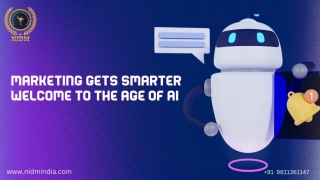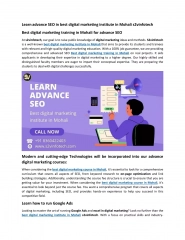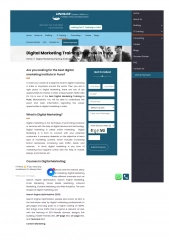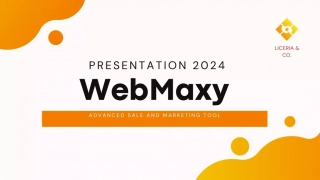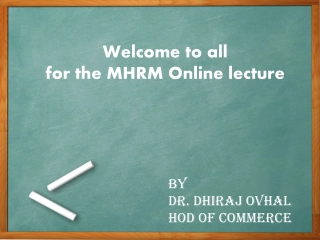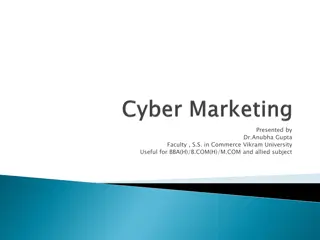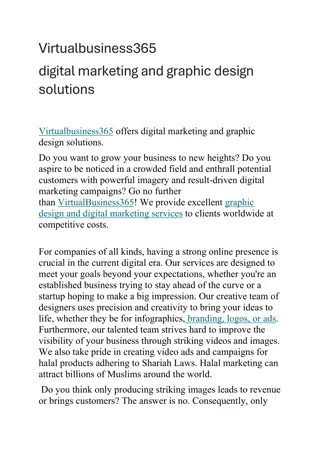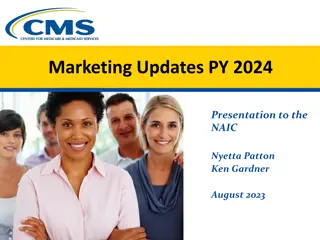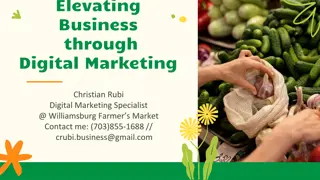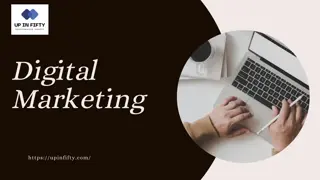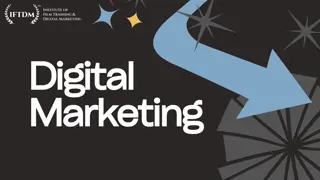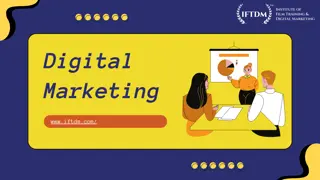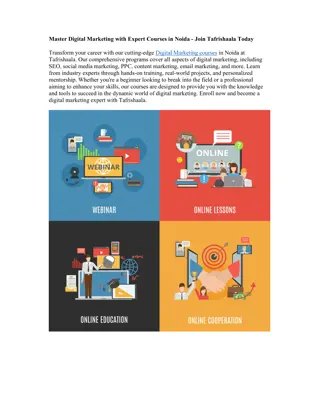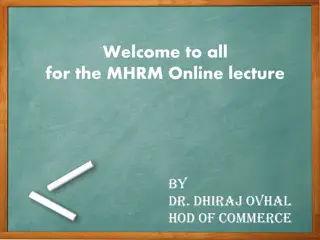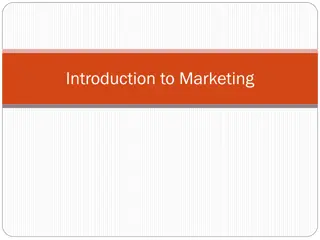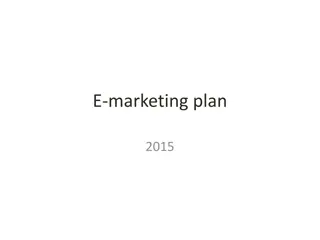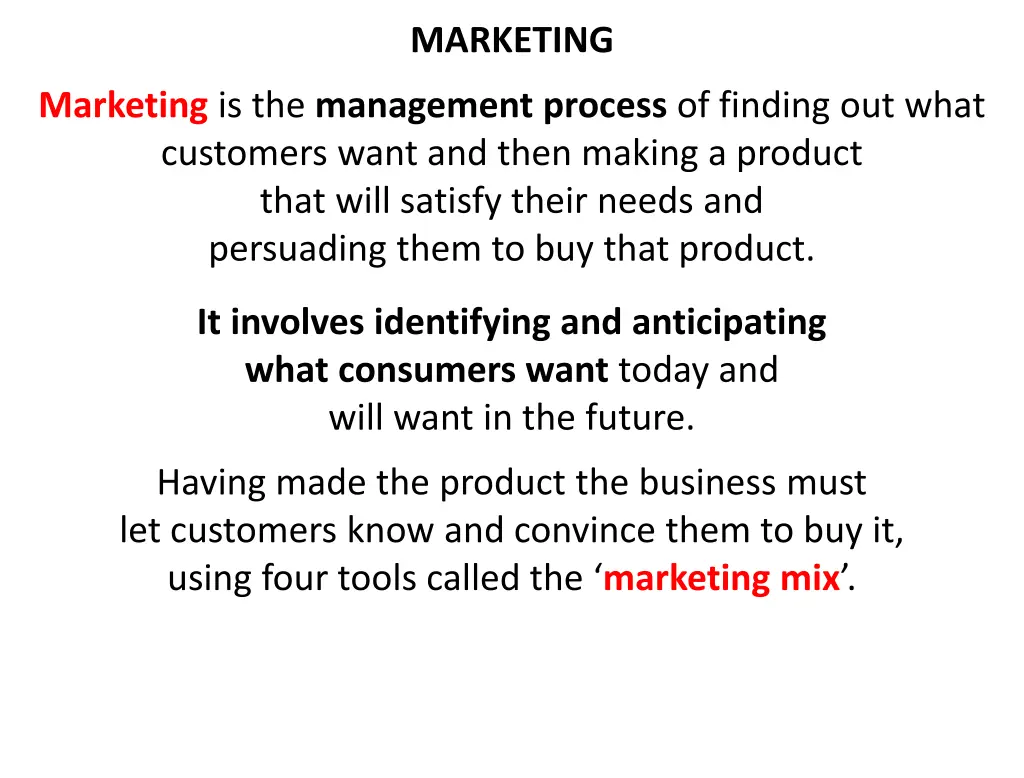
Understanding Marketing Research Techniques for Effective Decision Making
Explore the essential elements of marketing research, including field research and desk research, to make informed business decisions. Learn about observation, focus groups, surveys, internal reports, and more.
Download Presentation

Please find below an Image/Link to download the presentation.
The content on the website is provided AS IS for your information and personal use only. It may not be sold, licensed, or shared on other websites without obtaining consent from the author. If you encounter any issues during the download, it is possible that the publisher has removed the file from their server.
You are allowed to download the files provided on this website for personal or commercial use, subject to the condition that they are used lawfully. All files are the property of their respective owners.
The content on the website is provided AS IS for your information and personal use only. It may not be sold, licensed, or shared on other websites without obtaining consent from the author.
E N D
Presentation Transcript
MARKETING Marketing is the management process of finding out what customers want and then making a product that will satisfy their needs and persuading them to buy that product. It involves identifying and anticipating what consumers want today and will want in the future. Having made the product the business must let customers know and convince them to buy it, using four tools called the marketing mix .
MARKET RESEARCH Market research is the systematic collection, recording, analysis and reporting of information about marketing issues, so as to enable managers to make effective marketing decisions in order to satisfy consumers needs. It is carried out for a number of reasons, including: To identify customer needs To establish the market size and location To assess the competition To decide on packaging and price To choose the best advertising
MARKET RESEARCH (cont.) There are two ways to carry out market research: FIELD RESEARCH Going into the marketplace and collecting information directly from consumers primary research . The questions are specifically designed. The techniques used include: Observation Focus Group Survey DESK RESEARCH This involves using information that someone else has already gathered secondary research . The information already exists. The sources used include: Internal Reports Publications Internet
Field Research 1. Observation watching customers in action and how they behave/react. 2. Focus Group a small group of consumers brought together to discuss the business and its products. 3. Survey interviewing consumers directly, by phone, post, internet or face-to-face. The consumer is asked questions and the answers are recorded. Surveys produce: Qualitative data people s feelings, opinions, preferences, etc. Quantitative data statistical facts and figures.
Advantages of Field Research: It allows the business to address issues specific to its situation directly from the target market . The business owns the information and does not have to share it with anyone. The business will have full control over the whole research process and methodology it can trust that the results are accurate. It obtains immediate information about what is happening right now it is recent and up to date.
Disadvantages of Field Research: It costs a lot of money to conduct field research, e.g. printing costs, labour costs. Field research can take a lot of time to complete if done correctly, e.g. implementing a research plan.
Desk Research 1. Internal Reports, e.g. sales reports, financial reports. 2. Publications, e.g. the Census, the Household Budget Survey and other reports from the CSO. 3. Internet obtain information from the web on any topic it wants. It can access: (a) business/organisation websites, and (b) user groups.
Advantages of Desk Research: It costs a lot less to obtain information from secondary sources. Secondary data can be obtained more quickly. There is an extensive amount of data available. It can be the starting point for primary research highlights issues, background information, etc. Disadvantages of Desk Research: Data tends to be less accurate and reliable. The data may be out of date. Secondary research is freely available, so competitors have access to it as well.
IMPORTANCE OF MARKET RESEARCH 1. Market research can save the business money in the long run by finding out what consumers want the business avoids making products that no-one wants. 2. It reduces the risk of failure for the product and the business the business s products are more likely to sell successfully. 3. It helps a business to identify new markets a business can discover products/services that customers want but are not currently available. 4. It helps a business to identify threats it identifies potential threats and sources of competition.
MARKET SEGMENTATION Most businesses do not try to create a single product that appeals to all customers, as people have different tastes. Therefore, a business will aim a product at a particular group of consumers a market segment. Market segmentation involves dividing the overall market into separate and distinct groups of consumers. The main ways to segment a market include: 1. Geographic dividing by geographical area. 2. Demographic dividing by population characteristics, e.g. age, gender, income, etc.
Advantages of Market Segmentation: 1. Market segmentation allows a business to increase sales by targeting a previously neglected market segment. 2. It helps to lower marketing costs by being able to target a particular market segment with an appropriate marketing campaign. 3. Market segmentation allows a business to get a foothold in a market by starting off small in one particular segment and then growing the business.
TARGET MARKET A business will choose a segment of the market that it believes will like its products/services and where it might have a competitive advantage this is the target market . NICHE MARKET A niche market is a small group of potential customers within a market segment a gap in the market. For example, in the shoe industry a market segment is shoes aimed at women, and a niche market would be bridal shoes. Advantages of Niche Marketing: 1. It faces less competition, and can demand higher prices. 2. It lowers marketing costs by being able to target a specific market.
MARKETING CONCEPT Once the business has researched the market and knows consumers wants and needs, it then makes products that will satisfy those needs. The final step is to get consumers to buy their products. This is done by adopting the marketing concept and having an effective marketing plan and marketing mix. The marketing concept states that the customer is the most important person to the business.
MARKETING CONCEPT (cont.) Keeping customers happy is the way to make money. When customers are treated well and get good quality products and services, then: 1. They are happy and so they buy more increased sales and profits. 2. The business s reputation spreads by word of mouth, and this results in enhanced goodwill/a good reputation for the business. 3. There are fewer returns and/or repairs this reduces potential business costs.
MARKETING PLAN/STRATEGY The marketing plan is a written plan that sets out the business s marketing objectives and the means by how they will be achieved. Benefits of a Marketing Plan: It sets out the strategies that a business must take in order to attract and keep customers, increase sales and profits. It helps the business to control its progress, by measuring actual performance against the goals. It shows potential investors that the business knows its market, and thereby persuade them to invest.
MARKETING MIX PRODUCT The 4Ps of the marketing mix: PRODUCT PRICE PROMOTION PLACE TARGET MARKET PRICE PLACE The business will aim to have a good product at the right price in all the right places (markets) using suitable promotion. PROMOTION 16
MARKETING MIX PRODUCT A product is defined as a bundle of benefits that satisfies the needs or wants of consumers, i.e. it is something the consumer wants to buy. The business must consider the following: Brand Name Product Design Packaging Product Life Cycle 17
PRODUCT (cont.) A brand name is a name, design and/or a symbol given to a product to make it easy for consumers to identify it. It helps the product to stand out from the competition and builds up customer loyalty, e.g. Sony, Coca-Cola, Tayto. The benefits of branding include: 1. Businesses can charge a higher price and increase profits. 2. Branding helps a business to increase sales. 3. It makes consumers brand loyal . 4. It is easier to launch new products under the brand name. 5. The business can get a better deal from retail outlets.
Own-brand products:products that carry the name of the shop or a brand name developed for that retailer. Advantages of own-brand products: Customers: 1. They are cheaper than leading brands but of equally good quality. 2. Offer customers more choice. Retailers: 1. Can offer customers lower priced goods in competition with discount retailers. 2. It gives the retailer a competitive advantage. 3. The retailer can get a large discount from the manufacturer for bulk buying. 4. The retailer has more negotiating power with brand name suppliers.
PRODUCT (cont.) PRODUCT DESIGN Product design is the process of creating a product which is attractive and appealing to customers and which works excellently. Good product design incorporates: Aesthetics how the product looks. Function it must do the job that it was intended and designed to do. Cost-effectiveness can be made at a reasonable cost, easy to assemble, etc.
PRODUCT (cont.) Importance of Product Design: 1. Good design increases sales customers want well- designed products, easy to use and that look good. 2. Good design reduces costs well-designed products do what they were intended to do, and hence there are fewer recalls and repairs, lower replacement costs, etc. 3. Good design saves time products are easy and cost effective to manufacture.
PRODUCT (cont.) PACKAGING Product packaging is the container or wrapping in which the product is offered for sale, and can consist of a variety of materials, e.g. glass, paper, metal, plastic. Packaging is important for the following reasons: 1. Increased Sales attractive and eye-catching packaging gets customers attention and hence increases sales. 2. Protection protects the product during transportation and storage. 3. Information includes details of the contents, clear instructions, ingredients, a sell-by date, etc. 4. Image used to display the product and convey an image. 5. Convenience different size packaging for differing uses and different customers.
PRODUCT (cont.) Product Life Cycle: Sales of a product change over time. It shows the various stages a product may go through from when it is introduced to the market to when it leaves the market. Businesses can use their knowledge of the product life cycle to develop the best strategy for their products for the stage they are at: Introduction Growth Maturity Saturation Decline
Product Life Cycle Sales Maturity Introduction Growth Decline Saturation
Product Life Cycle (cont.) The FIVE stages are: 1. Introduction the business launches the product and sales grow slowly at first. Money spent on promotion. High risk of failure. Price skimming may be used. 2. Growth sales begin to rise if the product has proved successful. Profits start to increase. Increased competition. Persuasive advertising campaigns used. 3. Maturity the rate of sales growth decreases. Prices may be reduced to maintain market share. Advertising and sales promotion are increased.
Product Life Cycle (cont.) 4. Saturation sales remain at their peak, but there is no more growth. Prices may further drop to maintain sales. Brand loyalty becomes critical. Many other competitors in the market. Non-price competition is used plus advertising and sales promotion. The product may be altered, updated or replaced by a better one. 5. Decline sales of the product fall off permanently. Consumer tastes move away from the product. Management will have to decide whether to continue with extensive advertising to attract consumer attention or let the product die.
How to Extend a Products Life Cycle: Product bring out new and improved versions. Improve the design of the product to attract new customers and also alter the packaging. Price can drop the price at the saturation stage so as to make the goods appealing to new customers. Promotion use a different promotional technique or promoting it a different way, e.g. promoting new uses for the product. Place use a different distribution channel, e.g. sell the products online.
MARKETING MIX PRICE The price is the amount of money the business charges consumers for the product. When setting the price the business should consider: 1. Cost of the Product the price should at least equal to the cost of making and selling the product. This is the breakeven price, i.e. the absolute minimum. 2. Competitors Prices must be in line with competitors prices. 3. Consumers how much can its customers afford to pay for it or are willing to pay? 4. Legal Regulations taxes (e.g. excise duties, VAT) will increase the price. In exceptional cases the government can set the maximum/minimum price.
PRICING STRATEGIES The main pricing strategies are: 1. Price Skimming the business charges a high price when the product is launched, as customers will pay to be first to have it. The price will be reduced at a later stage. 2. Penetration Pricing is where the firm deliberately charges a lower price so that it is cheaper than its competitors and the business increases market share. 3. Premium Pricing involves charging a high price for goods which have a luxury image and status, e.g. designer clothes, Rolex watch.
PRICING STRATEGIES (cont.) 4. Price Discrimination the business charges different customers different prices for its product, e.g. student discount. 5. Loss Leader this is when a business sells a product below cost price so as to attract customers into the business in the hope they will buy other products. 30
MARKETING MIX PROMOTION Promotion involves communicating with customers to let them know about the product and to persuade them to buy it. There are four main ways to promote a product: 1. Advertising 2. Sales Promotion 3. Public Relations 4. Personal Selling
PROMOTION 1: ADVERTISING Advertising is the paid, non-personal communication of information about a product or service through various media. The main functions of advertising are: Remind consumers about a product, brand, etc. Informconsumers about the product s features, etc. Persuadepeople to buy the business s product/service.
ADVERTISING (cont.) The main types of advertising are: 1. Reminder Advertising lets consumers know that the product is still there and keeps it in the consumer s mind. Tends to be used in the maturity and decline stages. For example, Coca Cola uses reminder advertising to build up a memory bank of positive associations in consumers minds. 2. Informative Advertising gives factual information to consumers about the product s features, sales events, etc.
ADVERTISING (cont.) The main types of advertising are: 3. Persuasive Advertising aims to convince consumers that they must have the product/service. 4. Generic Advertising this advertises the product of an entire industry rather than one firm s product, e.g. Buy Irish . 5. Comparative Advertising when a business compares its product/service to a competitor s offering. It aims to show that it is much better than its competitors.
ADVERTISING (cont.) The different places where a business can place an advert are called the advertising media. Advertising Medium 1: Internet The internet is a good advertising medium because: Global audience increased sales Cost-effective Social media allows direct contact with consumers Can use websites that reach the target market(s) Adverts can use pictures, sound and movement. The problems with internet advertising include: Advertising material can easily be copied (illegal) Many people ignore or block internet ads.
ADVERTISING MEDIA (cont.) Advertising Medium 2: Television TV is a good medium because: Can be shown how well the product works live TV is widely watched Can reach its target market by identifying time frames, programmes or channels Adverts can use pictures, sound and movement The problems with TV advertising include: It is expensive Many people no longer watch TV ads they fast- forward through ads or switch channels
ADVERTISING MEDIA (cont.) Advertising Medium 3: Radio Radio is a good medium because: Very popular medium and can reach a large audience either nationally or locally Costs a lot less than TV Can reach local audiences by using local radio stations Can also reach its target market by advertising on specific stations or during specific programmes One of the problems with radio advertising is: It has to rely on sound only to get its message across.
ADVERTISING MEDIA (cont.) Advertising Medium 4: Newspaper Newspapers are a good advertising medium because: Can provide a lot more detailed written information It costs a lot less than TV Can advertise on newspapers that it knows its target market reads Can reach local people by using local newspapers The problems with newspaper advertising include: The quality of pictures displayed is not as good as TV The ad will only be seen for one day
ADVERTISING MEDIA (cont.) Advertising Medium 5: Magazines Magazines are a good medium because: Can provide a lot of detailed written information Pictures can be in colour and in better quality Have a longer life than newspapers, e.g. passed to others, left in waiting rooms It costs a lot less than TV advertising Business can advertise in magazines that it knows its target market reads
ADVERTISING MEDIA (cont.) Advertising Medium 6: Billboards Billboards are a good medium because: They cost a lot less than TV advertising They have a longer life than other media Can reach a local target market by placing different posters in different areas The business is not competing with other businesses for consumers attention only one ad on display The problems with billboard advertising include: The business cannot give detailed information Cannot predict who will see the billboard so may not reach its target market precisely
ADVERTISING MEDIA (cont.) Advertising Medium 7: Direct Mail Direct mail is a good medium because: The business can personalise the advertising material being delivered, so it is more likely to be read Can reach its target market effectively by only sending the advertising directly to them Direct mail only contains the one ad and is not competing with other businesses The problems with Direct Mail advertising include: It is expensive printing and postage costs Many consumers ignore junk mail
ADVERTISING MEDIA (cont.) Selecting an Advertising Medium: When deciding which medium to use, a business will consider the following: Media habits of the Target Market use media that will most likely reach the specific target market. Nature of the Product the type of product will influence which medium is more suitable, e.g. need for an active visual display will suit TV. The Message if a lot of technical information is needed then a written medium is more suitable. The Cost different media cost different amounts so it will depend on the business s advertising budget.
ADVERTISING STANDARDS AUTHORITY FOR IRELAND (ASAI) The ASAI keeps an eye on the advertising industry to ensure that consumers are protected. This means that it tries to protect consumers from false, misleading and offensive advertisements. The ASAI is a voluntary organisation, set up by people working in the advertising industry, and it has no legal powers. Generally, all advertisers obey the ASAI s ruling. Its code of advertising standards states that all ads should: Be legal, decent, honest and truthful Be prepared with a sense of responsibility to consumers and society Obey the rules of fair competition
PROMOTION 2: SALES PROMOTION Sales Promotions are incentives, or short-term gimmicks, that a business offers consumers, usually for a limited period. The aim of sales promotion is to offer customers added value so that they are motivated to buy the product or more of the product. Sales promotion differs from advertising in that it offers the consumer an incentive to buy, whereas advertising offers a reason to buy.
SALES PROMOTION (cont.) A number of different sales promotion techniques include: Loyalty cards the business offers customers points with every purchase, which can be redeemed later, e.g. Boots Advantage Card. Free gifts the business offers customers a gift with every purchase, e.g. McDonald s Happy Meal . Money-off vouchers giving customers a coupon entitling them to a certain discount when they purchase the product, e.g. Dunnes. Competitions customers are offered the chance to win a valuable prize if they buy the product. This motivates people to buy the product/service.
SALES PROMOTION (cont.) A number of different sales promotion techniques include: Free samples the business offers customers a free trial of the product, e.g. cosmetics. Merchandising the business displays its products and lays out its store in an attractive and eye-catching way. It aims to attract customers attention and get them to buy products they hadn t intended buying, i.e. impulse buying .
PROMOTION 3: PUBLIC RELATIONS Public Relations (PR) refers to the efforts of a business to create and maintain a positive image of the business in the minds of consumers. PR endeavours to build a good relationship with consumers by obtaining favourable publicity. This is such an important area that many businesses employ a Public Relations Officer (PRO) to handle their PR.
PUBLIC RELATIONS (cont.) Functions of Public Relations: 1. Attract publicity when launching new products 2. Target certain customers sponsor events and causes that appeal to their target market and generate a positive reaction 3. Build an image that reflects well on the company may engage in public service activities so that consumers admire their efforts and buy more products 4. Defend products that have encountered bad publicity
PUBLIC RELATIONS (cont.) Techniques used in Public Relations: 1. Sponsorship financial support of an event or a group, so as to receive recognition and increase brand awareness 2. Public Service Activities activities that help the community, e.g. Tesco Community Fund 3. Social Media Influencers partnering with social media influencers who endorse the business/brand 4. News Conferences and Press Releases invite the media to a newsworthy event, e.g. creation of new jobs 5. Events road-shows, exhibitions, open days, etc.
PROMOTION 4: PERSONAL SELLING Personal Selling involves the business s salespeople meeting with consumers face-to-face to give them personalised advice specific to their needs. It hopes to build a relationship with them so as to get them to buy the product. The business relies on the salesperson s knowledge and expertise to convince the consumer to purchase the product, e.g. cosmetic counter, computer store.


